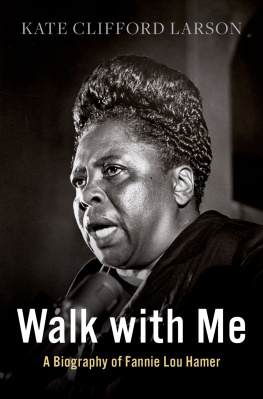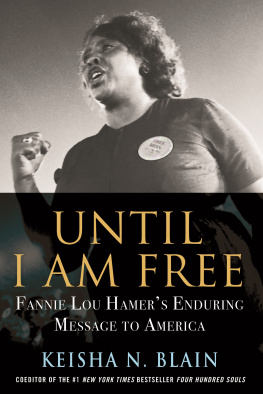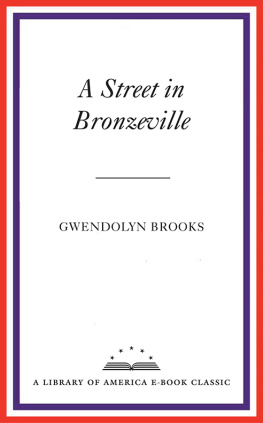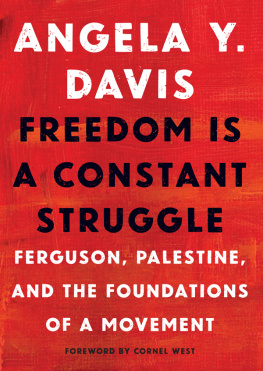www.upress.state.ms.us
Designed by Peter D. Halverson
The University Press of Mississippi is a member of the Association of American University Presses.
Copyright 2014 by University Press of Mississippi
All rights reserved
Manufactured in the United States of America
First printing 2014
Library of Congress Cataloging-in-Publication Data
Brooks, Maegan Parker.
A voice that could stir an army : Fannie Lou Hamer and the rhetoric of the Black freedom movement / Maegan Parker Brooks.
pages cm. (Race, rhetoric, and media series)
Includes bibliographical references and index.
ISBN 978-1-62846-004-9 (cloth : alk. paper) ISBN 978-1-62846-005-6 (ebook) 1. Hamer, Fannie Lou. 2. African American women civil rights workersBiography. 3. Civil rights workersUnited StatesBiography. 4. African American women civil rights workersMississippiBiography. 5. Civil rights workersMississippiBiography. 6. Civil rights movementsUnited StatesHistory20th century. 7. Civil rights movementsMississippiHistory20th century. 8. African AmericansCivil rightsHistory20th century. 9. African AmericansCivil rightsMississippiHistory20th century. I. Title.
E185.97.H35B76 2014
323.092dc23
[B] 2013039752
British Library Cataloging-in-Publication Data available
To my dear husband, David W. Brooks, who encourages me to follow my dreams and enables me to do so
INTRODUCTION
I Dont Mind My Light Shining
I never thought in a million years that Fannie Lou Hamer would be on a postage stamp, Vergie Hamer Faulkner exclaimed as the United States Postal Service included her mother among the twelve civil rights pioneers honored in celebration of the NAACPs one hundredth anniversary.
Closer to home, the Mississippi State Legislature formally recognized Hamer as a symbol for people in Mississippi and across the nation who struggled for human dignity and government open to all its citizens. And in her hometown of Ruleville, a memorial garden replete with a nine-foot-tall bronze statue of the civil rights stalwart pays tribute to her legacy.
Friends, fellow activists, and historians alike define that legacy in terms of representation. Famed singer and Student Non-Violent Coordinating Committee (SNCC) supporter Harry Belafonte contends that in Hamers voice he could hear the struggle of all black America. When she sang, he continues, there was indeed a voice raised that was, without compromise, the voice of all of us.
A Voice That Could Stir an Army, written as a rhetorical biography, both reconstructs and critically considers Hamers symbolic legacy. It also traces what about those symbols changes and what remains consistent in response to shifts in her personal life and changes in historical context. In a second vein, this study is guided by questions about Hamers symbolic legacy, asking: what is rhetorical about her biography? How has Hamers life story been used to persuade, which audiences, for what purposes? What is the potential and what are the limitations of her symbolic status as aspects of her persona continue to circulate within society?
Nearly twenty years after Kay Mills first published This Little Light of Mine: The Life of Fannie Lou Hamer and a decade after Chana Kai Lees ForFreedoms Sake: The Life of Fannie Lou Hamer was released, this rhetorical biography has Put simply, the core difference between a traditional biography and a rhetorical biography is acknowledgment versus analysis. Mills and Lee both acknowledge Hamers rhetoric but, given their biographical focus, they rarely offer analysis of how her discourse operated in context, shaped/was shaped by her activism, and conveyed her sense of self.
Hamers affinity for the spoken word, her self-perception as a prophet, and the lasting impact her use of symbols had upon those who experienced her discourse suggest that a sustained rhetorical analysis of Hamers contribution to mid-twentieth-century human rights struggles is due. Hamers careful rhetorical consideration invites a similarly sustained scholarly approach to understanding the richness of her discourse.
The dearth of rhetorical scholarship about Hamer, the mischaracterization of her rhetorical signature, and the related apocryphal conceptions about how she gained and sustained a platform for her expression can be largely attributed to the limited number of her published speeches that existed prior to the 2011 publication of The Speeches of Fannie Lou Hamer: To Tell It Like It Is. Although both historical and rhetorical scholars had included Hamers
Featuring Hamer as exemplar, this rhetorical biography provides a glimpse into the complex role rhetoric played within various aspects of mid-twentieth-century civil and human rights struggles in the United States. Just as this study stands on the shoulders of previous biographical works about Hamer and is informed by advances in rhetorical studies, it is also influenced by the historiographical shift away from the conservative master narrative of civil rights history.
Informed as they are by oral histories of movement participants and its detractors, studies written in the bottom-up vein are recovering the nuance and complexity of local struggles by revealing differences among black freedom advocacy groups, as well as detailing arguments between advocates of social The master narratives focus on a few larger-than-life leaders, its emphasis on national victories, and its triumphalist overtones belie the work that remains to be done, conceal the range of advocates with the potential to participate, and mask the ideologies that perpetuate white privilege and continue to disempower African Americans.
The bottom-up approach to studying the civil rights movement frames this study, which begins by taking a long, localized, and nuanced view of the traditions of white supremacy and black resistance in which Hamer was reared. Considering the significant spaces Hamer occupiedher home, the plantation, and the black Baptist church, A Rhetorical Education, 19171962, examines Hamers life from birth to age forty-four, when she became involved with SNCC. This examination reveals that though she never received a formal education, Hamer patched together a remarkable rhetorical education that she later transferred to her voter-registration, community-organizing, and fundraising efforts.
Is This America?, 1964, the projects third chapter, compares Hamers famous 1964 Democratic National Convention (DNC) testimony to an equally riveting, yet lesser known, speech she delivered just weeks later in Indianola, Mississippi. Analyzing the two texts in their historical context explains what was memorable, compelling, and persuasive about each. It also reveals how she adapted the Jeremiadic rhetorical structure, which was becoming her signature mode of reasoning, to appeal to markedly different audiences. Comparing the two texts to each other, furthermore, sheds light on the construction of Hamers plainspoken sharecropper persona as well as the ways in which this symbolic status belied her intellect and the complexity of her activist message.











